|
80x5 -
240x3 -
240x4 -
320x1 -
320x2 -
320x3 -
640x1 -
640x2
Set display option above.
Click on
images to enlarge. |
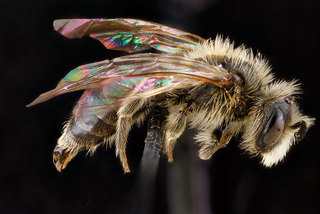
© Copyright source/photographer
· 9
Andrena nasonii, -unknown, -side 2012-06-06-13.21.14 |
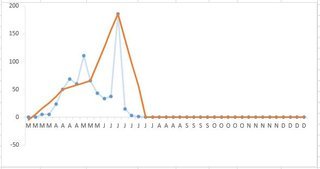
© Copyright source/photographer
· 9
Andrena nasonii, Mid-Atlantic Phenology |
|
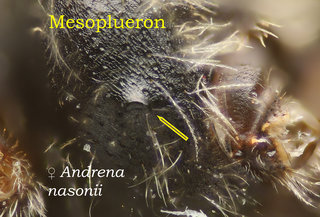
© Copyright source/photographer
· 9
Andrena nasonii, female, thorax, mesopleuron, tubercle, nasonii |
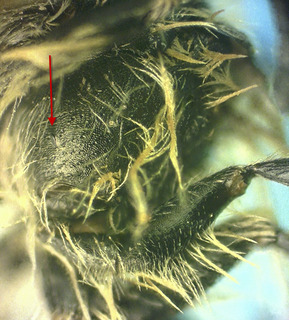
Deana Crumbling · 8
Andrena nasonii, male, raised pleural signum tubercle |
|
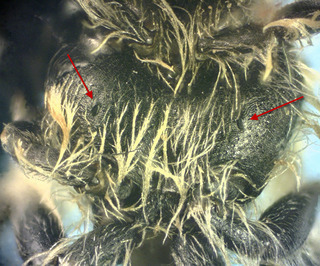
Deana Crumbling · 8
Andrena nasonii, male, pleural signum tubercles |
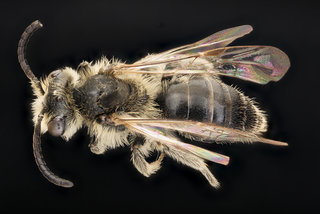
© Copyright source/photographer
· 7
Andrena nasonii, m, back, Pr. Georges, MD |
|
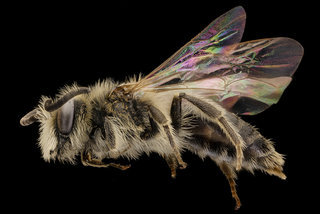
© Copyright source/photographer
· 7
Andrena nasonii, m, left, Pr. Georges, MD |
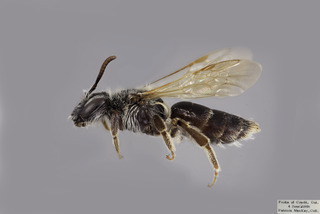
© Copyright Laurence Packer 2014
· 7
Andrena nasonii FEM CFP comp |
|
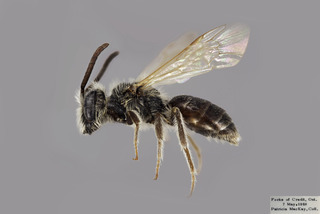
© Copyright Laurence Packer 2014
· 7
Andrena nasonii MALE CFP comp |
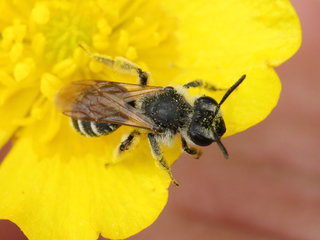
Michael Veit · 6
Andrena nasonii f, on Ranunculus -- |
|
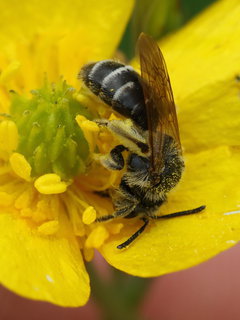
Michael Veit · 6
Andrena nasonii f, on Ranunculus -- |
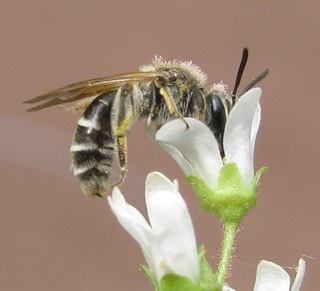
Beatriz Moisset · 5
Andrena nasonii, Beatriz Moisset 2 |
|
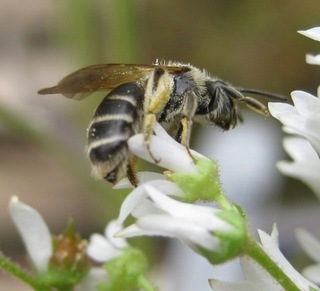
Beatriz Moisset · 5
Andrena nasonii, Beatriz Moisset |
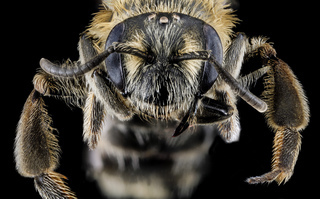
© Copyright source/photographer
· 5
Andrena nasonii, F, face, New York, Kings County |
|
Overview |
Reprinted with permission of the American Entomological Society from:
LaBerge, W. E. 1989. A revision of the bees of the genus Andrena of the Western Hemisphere. Part XIII. Subgenera Simandrena and Taeniandrena. Transactions of the American Entomological Society 115: 1-56.
Please report text errors to: leah at discoverlife dot org.
Andrena nasonii is a common polylectic Eastern species. Both sexes of nasonii can be recognized by the pleural signum of each mesopleuron being slightly elevated, giving the appearance of being tuberculate. This tuberculate signum occurs in about 90 percent of the specimens examined by me, the remainder have the signum flat as in other species of the subgenus. Both sexes have a clypeus that is dulled by dense shagreening, vein r usually extremely short, well-formed tergal pubescent fasciae, and short vertices. The female has broad facial foveae and cuneate hind tibiae with extremely short, largely simple hairs. The male has relatively long antennae reaching at least the middle of the scutellum in repose, with flagellar segment 1 about as long as segment 2.
FEMALE. MEASUREMENTS AND RATIOS. � N = 20; length, 7-9 mm; width, 1.5-2.5 mm; wing length, M = 3.03 � 0.130 mm; FL/ FW, M = 1.07 � 0.005; FOVL/FOVW, M = 3.27 � 0.053.
INTEGUMENTAL COLOR. � Black except as follows: mandible with apical third or less rufescent; wing membranes hyaline, colorless or moderately yellow, veins dark red (o yellow, pterostigma usually yellow; metasomal tergal apical areas usually translucent dark reddish brown to almost colorless at apices; distitarsi dark reddish brown; tibial spurs testaceous.
STRUCTURE. � Antennal scape as long as first four and one-third flagellar segments; flagellar segment 1 distinctly shorter than segments 2 and 3 together, segment 2 slightly shorter than 3, segments
2 and 3 broader than long. Eyes each about four times as long as broad, inner margins converging slightly toward mandibles. Malar space short, linear. Outer mandible when closed extends beyond midlabrum by less than one-fifth mandibular length, without tooth or angle on basal inferior margin. Galea with outer apical margin concave; surface dull, shagreened. Maxillary palpus longer than galea by about last two palpal segments; segmental ratio about as 1.0:1.0:0.8:0.8:0.7:0.7. Labial palpus with first segment long, curved, slightly flattened; segmental ratio about as 1.0:0.6:0.4:0.4. Labral process trapezoidal to rounded apically, occasionally weakly emarginate apically, surface shiny; labrum apical to process without cristae. Clypeus moderately flattened; punctures present but weak and obscured by dense tessellation. Supraclypeal area dulled by minute crowded punctures and fine shagreening. Face above antennal fossae with fine parallel rugulae reaching ocelli. Facial fovea broad, shallow, separated from lateral ocellus by about one and one-half ocellar diameters. Vertex above lateral ocellus equals half an ocellar diameter or slightly more, distinctly less than one ocellar diameter. Genal area in profile slightly broader than eye; punctures minute, sparse, surface opaque, shagreened.
Pronotum without humeral angle and dorsoventral ridge; surface dulled by fine regular shagreening. Mesoscutum with small punctures separated mostly one to three puncture widths or more, surface dull, tessellate; scutellum and metanotum similar. Propodeum with dorsal enclosure with fine irregular rugulae, lateral sutures distinct, slightly raised; dorsolateral surfaces with small round punctures, opaque, tessellate; lateral surfaces opaque, coarsely tessellate. Fore wing with vein r short, usually equal to two or three vein widths.
Metasomal tergum 1 with basal area with small, shallow, round punctures separated mostly by half to one punctures width, surface reticularly shagreened, shagreening often obscuring punctures; apical areas impunctate or with sparse shallow punctures basally. Tergum 2 with basal area with small round punctures separated mostly by half a puncture width or less except sparse near apical area, punctures usually obscured by dense reticular shagreening; apical area impunctate, densely shagreened, dull. Terga 3 and 4 similar but punctures less distinct. Pygidial plate V-shaped with rounded apex, with strong raised internal triangular area. Sterna 2-5 with basal areas sparsely punctate toward bases, more densely so near apical area, surface moderately shiny, reticularly shagreened; apical areas dull, punctate and tessellate.
VESTITURE. � White to pale ochraceous. Tibial scopal hairs occasionally brown near basitibial plate and along posterior half; short, apicomedially less than half as long as apical width of tibia, simple except along anterior and posterior margins of scopa. Propodeum with corbiculum complete, internal hairs lacking. Trochanteral flocculus complete, small. Metasomal terga 2-4 with pale apical fasciae but usually interrupted medially on tergum 2 and occasionally narrowly so on tergum 3.
MALE. MEASUREMENTS AND RATIOS. � N = 20; length, 6-8 mm; width, 1-2 mm; wing length, M = 2.71 � 0.144 mm; FL/FW, M = 1.12 � 0.007; FS1/FS2, M = 1.02 � 0.016.
INTEGUMENTAL COLOR. � As in female except as follows: mandible with apical fifth to fourth rufescent; Flagellar segments 2-11 dark brown below; metasomal terga with apical areas usually yellowish brown to hyaline, more frequently hyaline than female.
STRUCTURE. � Antennal scape as long as first two and one-half flagellar segments; flagellar segment 1 about as long as segment 2 and slightly shorter than segment 3, median segments longer than broad. Malar space and galea as in female. Maxillary palpus as in female but segmental ratio about as O.'7:l. 0:0.9:0.9:0.7:0.9. Labial palpus as in female but ratio about as 1.0:0.'7:0.5:0.7. Labral process as in female but apical margin usually gently emarginate; sur-face slimy; labrum apical to process without crista. Clypeus dull, opaque, finely tessellate, with small round punctures often obscured by tessellation. Supraclypeal area, face above antennal fossae, and vertex as in female. Genal area in profile slightly broader than eye; surface dulled by minute sparse punctures and fine shagreening.
Pronotum as in female. Thoracic sculpturing as in female but mesoscutum and scutellum impunctate or punctures extremely minute and sparse; propodeum with dorsal enclosure with rugulae less distinct, irregular. Metasomal sculpture as in female but punctures, especially on tergum I, absent or extremely weak; terga 2-5 with basal area punctures more sparse; sternum 6 flat. shallowly emarginate apically. Terminalia as in Figures 6-10.
VESTITURE. � While to pale ochraceous. Metasomal terga 2-5 without pale apical fasciae or weak and reduced to short lateral fasciae. Sterna 2-5 without subapical fimbriae.
Reprinted with permission from: Mitchell, T.B. 1960. Bees of the Eastern United States. North Carolina Agricultural Experiment Station Technical Bulletin No. 141.
FEMALE. � Length 8 mm.; clypeus broadly convex, projecting about one-third below suborbital line, rather dull, punctures shallow and rather fine, well separated but not sparse, except for an indefinite, narrow, median, impunctate line; facial foveae broad, occupying above most of area between eyes and ocelli, covered with whitish tomentum; space between margin of vertex and lateral ocelli no more than half their diameter; cheeks subequal to eyes in width, rounded posteriorly, smooth, punctures hardly evident, but surface somewhat obscured by the rather dense pubescence; malar space lacking; basal segment of flagellum subequal to 2nd and 3rd combined; process of labrum rather large, length about half the basal width, slightly narrowed to the broadly truncate apex; pubescence of dorsum of thorax pale ochraceous, elsewhere on head, thorax and legs, whitish-ochraceous; thoracic integument dull, rather densely tessellate, punctures of scutum fine but distinct, well separated but not sparse, those on scutellum much finer and closer, rather obscure; anterior portion of pleura with a few very obscure, scattered punctures; dorsal area of propodeum nearly vertical in position, triangle rather coarsely granular or subrugose; propodeal corbicula well developed, with a short but distinct anterior fringe, whitish in color; trochanteral floccus rather well developed, whitish; hind tibiae broadened apically, apex fully twice as broad as basitarsi, scopa whitish, rather dense, composed of very short, simple hairs; front and middle basitarsi distinctly narrower than their respective tibiae; 2nd submarginal cell much shorter than 3rd, receiving 1st recurrent near middle; abdominal terga dull, quite densely tessellate, very slightly tinged with greenish, very minutely, closely and indistinctly punctate, apical impressed areas impunctate, rather shallow and narrow, becoming hyaline along rims, discal pubescence very poorly developed on the more basal terga, short, suberect, very thin, entirely pale on the more apical terga, terga 2-4 with quite dense, whitish, apical fasciae, that on tergum 2 broadly interrupted medially, tergum 5 with a pale brownish, apical fimbria.
MALE. � Length 7 mm.; clypeus broadly convex, projecting slightly less than one-half below suborbital line, surface dull, with shallow, fine, obscure and rather close punctures; space between margin of vertex and lateral ocelli somewhat less than their diameter; cheeks subequal to eyes in width, rounded posteriorly, quite densely pubescent, surface rather smooth, punctures very obscure; malar space lacking; basal segment of flagellum subequal to 2nd segment; process of labrum rather broad and short, basal width about twice the median length, slightly narrowed to the rather broadly truncate tip; mandibles short, with a distinct, subapical, inner tooth, overlapping only slightly; pubescence of head, thorax and legs entirely pale ochraceous; thoracic integument dull, quite densely tessellate, punctures of dorsum of thorax very obscure, hardly visible; pleura without distinct punctures; dorsal area of propodeum somewhat vertical in position, triangle rather finely granular; all basitarsi slender and elongate, distinctly narrower than their respective tibiae; 2nd submarginal cell considerably shorter than 3rd, receiving 1st recurrent slightly beyond middle; abdominal terga smooth, but dull, very finely tessellate, punctures exceedingly minute and obscure, hardly visible, apical impressed areas narrow and quite shallow, becoming more or less hyaline toward rims, discal pubescence very obscure, short, thin, erect and entirely pale, fasciae very poorly developed; apical portion of sternum 8 rather short, gradually narrowed from base and slightly broadened to the truncate apex, without a distinct ventral protuberance; penis valves very narrow and very slightly bulbous toward base, not excavated, gonocoxites rather short, slender, only very slightly dilated apically, gonocoxal lobes rather distinctly but not markedly produced, narrowly rounded apically.
DISTRIBUTION. � Minnesota to Eastern Canada and the New England states, south to North Carolina, Georgia and Texas; March to July.
FLOWER RECORDS. � Acer, Apocynum, Claytonia, Crataegus, Forsythia, Fragaria, Ilex, Ligustrum, Potentilla, Prunus, Pyracantha, Ranunculus, Rubus, Senecio, Spirea, Toxicodendron, Viburnum and Viola. Robertson (1929) records nasonii on the following additional plant genera: Arabis, Capsella, Chaerophyllum, Polemonium, Polytaenia, Rhamnus, Sisymbrium, Taenidia and Zizia. Brittain & Newton (1934) record it on Amelanchier.
|
|
|
Kinds | |
Extracted from Joel Gardner. "The mining bees of Minnesota (unpublished manuscript)" Andrena nasonii is by far the more common of the two Minnesota Simandrena species.
Many individuals of A. nasonii have a small but distinct, squared-off tubercle low on the thorax,
between the fore- and mid-coxae. When this tubercle is present, it readily separates A. nasonii
from all other Minnesota Andrena. Individuals without the tubercle, however, are more difficult
to identify.
|
|
|
Identification | |
The pleural signum (lower portion of thorax between the insertion points of front and middle legs) in most specimens is raised to form a protrusion. Absence of the protrusion does not necessarily mean the specimen is NOT A. nasonii.
Extracted from: Charles Robertson (1900). Some Illinois Bees. Trans. Acad. Sci. Of st. Louis.
Male. Closley resembles the female; abdomen more shining pubescent fasciae almost obsolete; face narrowed below; clypeus finely roughened, with rather coarse, shallow punctures, hearded with long, thin, white pubescence; antennae long, joint three about as long as four, shorter than five. Length 6-8 mm.
Extracted from: Charles, R. (1895). Notes on bees, with Descriptions of New Species. Transactions of the American Entomological Society Vol. 22, No. 2. pp. 115-128.
♀-Black ; clypeus slightly convex, finely roughened,
with numerous shallow punctures; basal process of labrum short, triangular,
broadly truncate ; third joint of antenna? about the length of fourth and fifth
together, lateral depressions of face with the pubescence whitish, cheeks narrow ;
mesonotum opaque, finely roughened, with sparse punctures, pubescence ochraceous, disc of metathorax with triangular enclosure bordered by a raised line,
rather strongly reticulated. Wings hyaline, nervures and stigma pale testaceous,
tegula? mostly testaceous. Legs with pale pubescence, the scopa with rather short
hairs. Abdomen depressed, opaque, roughened with close shallow punctures,
apical margins of segments slightly and broadly depressed, narrowly testaceous,
with narrow whitish fascia?, interrupted anteriorly, fimbria pale ochraceous
Length 8-9 mm
|
|
|
Names | |
|
|
| Supported by | |
Updated: 2024-04-26 09:14:43 gmt
|